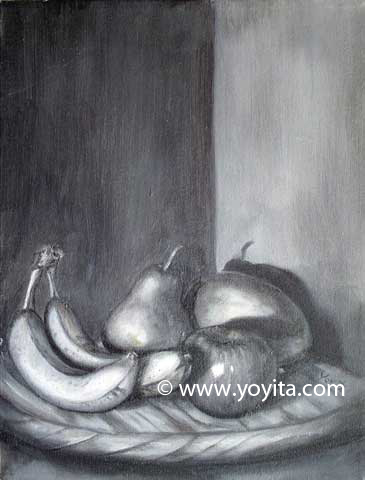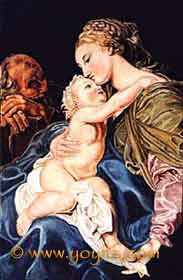|
|
Allegories and the Renaissance technique in the art of painting:
Allegory is a form of extended metaphor, in which objects, persons, and actions in a narrative, are equated with the meanings that lie outside the narrative itself. The underlying meaning has moral, social, religious, or political significance, and characters are often personifications of abstract ideas as charity, greed, or envy.
Thus an allegory is a story with two meanings, a literal meaning and a symbolic meaning.
We use allegories in painting.
For example the following painting is an allegory of a person.
The violin symbolizes this person and his love for music. His three daughters are the three brushes. The two tubes of painting are his two marriages.
To the right the bottom book symbolizes his career in Medicine.
The book in the middle, the one that has been used more symbolizes his specialization in Psychiatry.
The book on the top, the thin one symbolizes his love for foreign languages.
The candle in the back left symbolizes the light of knowledge and his life.

This painting is in grisaille (Renaissance technique), many layers of transparent colors will be applied later.
Yoyita
Atelier Yoyita
Arte Nicaraguense |
Other examples of the Renaissance Technique |

This still life has been started in grissaille with the Renaissance technique, after it dries, there will be numerous transparent layers applied on top. Many times the layers could be 20 or 30. Each layer should be truly dried before applying the next one. This makes the process very slow, because it requires 4 to 5 days to dry a layer. The painting has to be resting flat, to avoid dripping. It is time consuming, but the results is an immense depth which can not be achieved any other way, and after all the renaissance technique is the process of making a real work of art. |
Other examples of the Renaissance Technique
|
|
|
|
|
|
|
|
|
|
Technique de la Renaissance allégories | Allegories Renaissance technique | الرموز النهضه التقنيه | 寓言 文藝復興技術 | Allegorie Renaissancetechnik | Tecnica di rinascita Allegories | アレゴリー ルネサンスの技術 | 풍유 르네상스 기술 | Técnica do renascimento Allegories | Ренессанс метод аллегорий | |
An allegory (from Greek a????, allos, "other", and a???e?e??, agoreuein, "to speak in public") is a figurative mode of representation conveying a meaning other than and in addition to the literal. Through allegory a subject of a higher spiritual order is described in terms of that of a lower which is made out to resemble it in properties and circumstances, the principal subject being so kept out of view that we are left to construe the drift of it from the resemblance of the secondary to the primary subject.
Allegory is generally treated as a figure of rhetoric, but an allegory does not have to be expressed in language: it may be addressed to the eye, and is often found in painting, sculpture or some form of mimetic art. The etymological meaning of the word is wider than that which it bears in actual use. Though it is similar to other rhetorical comparisons, an allegory is sustained longer and more full in its details than a metaphor, and appeals to imagination where an analogy appeals to reason. The fable or parable is a short allegory with one definite moral.
Northrop Frye discussed the continuum of allegory from what he termed the "naive allegory" of The Faerie Queen to the more private allegories of modern paradox literature. The characters in a "naive" allegory are not fully three dimensional, for each aspect of their individual personalities and the events that befall them embodies some moral quality or other abstraction. The allegory has been selected first: the details merely flesh it out. Since meaningful stories are always applicable to larger issues, allegories may be read into many significant stories, sometimes distorting their author's overt meaning. J.R.R. Tolkien's distaste for allegory is famous: many people have suggested that Lord of the Rings was an allegory for the World Wars, an interpretation which the author sharply denied.
The allegory has been a favourite form in the literature of nearly every nation. The Hebrew scriptures present frequent instances of it, one of the most beautiful being the comparison of the history of Israel to the growth of a vine in Psalm 80:8-17. In the Rabbinic tradition fully-developed allegorical readings were applied to every text, with every detail of the narrative given an emblematic reading, a tradition that was inherited by Christian writers, for whom allegorical similitudes are the basis of exegesis, the origin of the arts of hermeneutics. The late Jewish and Early Christian visionary Apocalyptic literature, with its base in the Book of Daniel, presents allegorical figures, of which the Whore of Babylon and the Beast of Revelation are simply the most familiar.
In classical literature two of the best known allegories are the cave of shadowy representations in Plato's Republic (Book VII) and the story of the stomach and its members in the speech of Menenius Agrippa (Livy ii. 32); and several occur in Ovid's Metamorphoses. In Late Antiquity Martianus Capella organized all the information a 5th-century upper-class male needed to know into an allegory of the wedding of Mercury and Philologia, with the seven liberal arts as guests, an allegory that was widely read through the Middle Ages. In the late 15th century, the enigmatic Hypnerotomachia, with its elaborate woodcut illustrations, shows the influence of themed pageants and masques on contemporary allegorical representation. Some elaborate and successful specimens of allegory are to be found in the following works, arranged in approximately chronological order:




